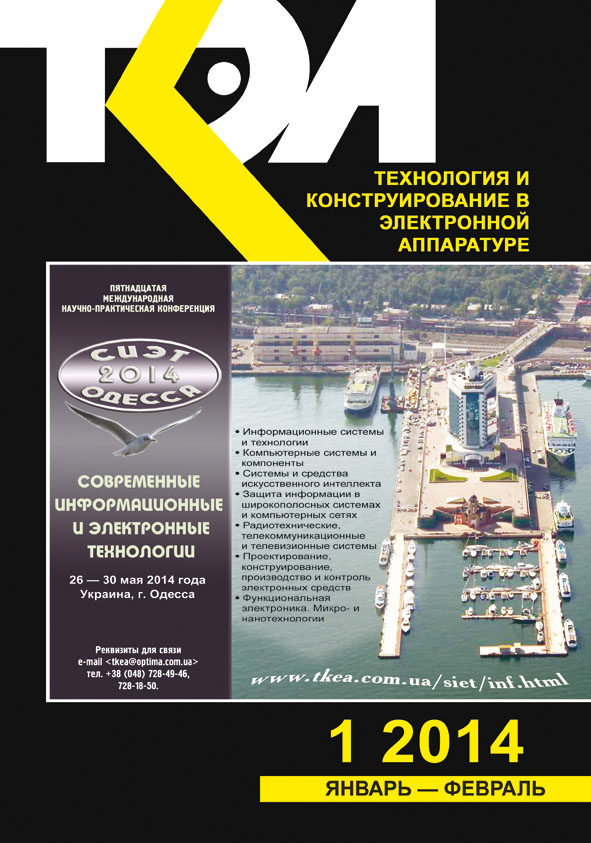Compensation of parasitic elements of transistor in the class F amplifier with the tuning of impedances at harmonics
Abstract
The authors present a new method of construction and calculation of the output load circuit (OLC) for class F power amplifiers (PA) with the addition of the third harmonic of the voltage. This method allows compensating the negative influences of parasitic elements of transistor (output capacitance — COUT, and inductance — LOUT) on the drain efficiency of the amplifier. The circuit of the parasitic elements was considered as a part of the proposed OLC. To calculate the OLC a system of three algebraic equations was compiled. The system is solved numerically relative to the three parameters of the OLC, for which the impedance on a chip of the transistor (on COUT) for odd and even harmonics corresponds to the theory of class F PAs. This method is applicable for the calculation of the OLC, which is realized in the frequency range of 300–500 MHz, where the use of elements with lumped parameters only is not always possible, while using elements with distributed parameters leads to a substantial increase in the size of the whole amplifier. In the developed OLC, the authors used elements with both lumped and distributed parameters, thus achieving a compromise between the geometric dimensions and physical realizability of the circuit elements. The proposed OLC, taking into account the parasitic elements of the transistor, allows setting impedances independently at the first and third harmonics while maintaining impedance at the second harmonic tending to zero. This makes it possible to optimize the drain efficiency at a given level of output power. The efficiency 72.5% was experimentally obtained at POUT = 1.045 W for the class F amplifier running at 400 MHz. The proposed methodology for constructing and calculating the OLC can be used to implement class F power amplifiers in the integrated-circuit form.
References
Krizhanovski V.G., Yefimovych A.P. [Effect of losses in resonant circuits on the amplifier class F] Radiotekhnika: vseukr. mezhved. nauch.-tekhn. sb. KhNURE, 2012, no 170, pp. 59-65.
Yefymovych A.P., Krizhanovski V.G. The methods of compensating parasitic elements of the transistor in class-F amplifier at the microwave range. Procced. of the 23th International Crimean Conf. «CriMiCo 2013», Ukraine, Sevastopol, 2013, pp. 98-99.
Kim J., Jo G., Oh J., Kim Y., Lee K., Jong J. Modeling and design methodology of high-efficiency class-F and class-F-1 power amplifiers. IEEE Transactions on Microwave Theory and Techniques, 2011, vol. 59, no 1, pp. 153-165.
Moon J., Jee S., Kim J., Kim B. Behaviors of сlass-F and class-F-1 amplifiers. IEEE Transactions on Microwave Theory and Tecniques, 2012, vol. 60, no 6, pp. 1937-1951.
Woo Y., Yang Y., Kim B. Analysis and experiments for high-efficiency class-F and iverse сlass-F power amplifiers. IEEE Transactions on Microwave Theory and Techniques, 2006, vol. 54, no 5, pp. 1969-1974.
Grebennikov A.V. Circuit design technique for high efficiency сlass F amplifiers. IEEE MTT-S International Microwave Symposium Digest, USA, Boston, 2000, vol. 2, pp. 771-774.
Grebennikov A.V. Load network design technique for class F and inverse class F power amplifiers. High Frequency Electronics, 2011, vol. 10, no 5, pp. 58-76.
Kenle C., Dimitrios P. Design of broadband highly efficient harmonic-tuned power amplifier using in-band continuous class-F1/F mode transferring. IEEE Transactions on Microwave Theory and Techniques, 2012, vol. 60, no 12, pp. 4107-4116.
Raab F. H. Maximum efficiency and output of class-F power amplifiers. IEEE Transactions on Microwave Theory and Techniques, 2001, vol. 49, no 6, pp. 1162-1166.
Colantonio P., Giannini F., Limiti E. HF сlass F design guidelines. Procced. of the 15th International. Conf. Microwaves «Radar and Wireless Communications», Poland, Warszawa, 2004, vol. 1, pp. 27-38.
Falco S., Raffo A., Vadala V., Vannini G. Lowfrequency waveform engineering technique for class-F microwave power amplifier design. Procced. of the 6th European Microwave Integrated Circuits Conf. (EuMC), UK, Manchester, 2011, pp. 288-291.
Vadala V., Raffo A., Falco S., Bosi G., Nalli A., Vannini G. Load-pull characterization technique accounting for harmonic tuning. IEEE Transactions on Microwave Theory and Techniques, 2013, vol. 61, no 7, pp. 2695-2704.
Materka A., Kacprzak T. Computer calculation of large-signal GaAs FET amplifier characteristics. IEEE Transactions on Microwave Theory and Techniques, 1985, vol. 33, no 2, pp. 129-135.
Datasheet archive. http://www.allcomponents.ru.
Fusko V. SVCh tsepi. Analiz i avtomatizirovannoe proektirovanie [Microwave circuit. Analysis and computeraided design] Moskow, Radio i svyaz', 1990.
Kazimierczuk M.K. RF Power Amplifiers, USA, Wiley, 2008.
Copyright (c) 2014 Yefymovych A. P., Krizhanovski V. G.

This work is licensed under a Creative Commons Attribution 4.0 International License.

